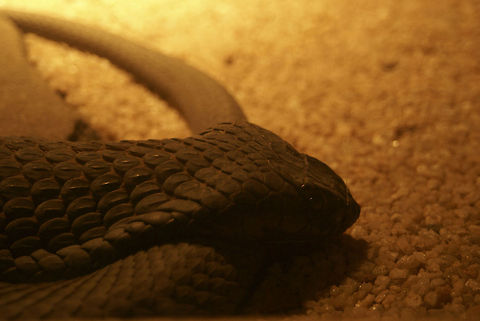
Appearance
Coloration varies throughout its distribution area, but a characteristic of the species is the belly is dark with one or two light-coloured crossbands on the throat. Their average length is 90–110 cm. Some individuals may have a mostly black body, while others are striped. Rinkhals scales are distinct from those of true cobras in that they are ridged and keel-like.Distribution
Scalation:⤷ dorsal scales are keeled
⤷ 17–19 rows of dorsal scales at midbody
⤷ 116–150 ventral scales
⤷ anal plate is entire
⤷ 30–47 subcaudal scales, paired
⤷ 7 upper labial scales
⤷ upper labials 3 and 4 entering the eye
⤷ 1 preocular
⤷ 3 postoculars
⤷ 8–9 lower labialsThis species is found in the Southern Cape province of South Africa, northeast through the Free State, Lesotho, Transkei, Kwazulu Natal, South Africa, Western Swaziland and parts of Gauteng, South Africa. An isolated population is centered around Inyanga on the Zimbabwe-Mozambique border.
Behavior
The rinkhals has a varied diet. Its main prey is toads, but it also eats small mammals, amphibians, and other reptiles.If distressed, the rinkhals spreads its hood, showing its distinctive, striped neck. It is a spitting snake, and can spray its venom up to 2.5 m. Its spitting mechanism is primitive and it has to rear up and fling its body forward to spray its venom. It is also known to fake death by rolling onto its back with its mouth agape.Habitat
The rinkhals generally prefers grassland habitats because it allows them to blend in with the surroundings. Rinkhals also may live in swamps around southern Africa.Food
The rinkhals has a varied diet. Its main prey is toads, but it also eats small mammals, amphibians, and other reptiles.Defense
The venom of the rinkhals is neurotoxic and partially cytotoxic, and is less viscous than that of other African elapids. When confronting a human, it generally aims its venom at the face. If the venom enters the eyes, it causes great pain.*The rinkhals is not in the same genus as other "true" cobras, it is in fact monotypic and not in the genus ''Naja''. Nevertheless, many experts consider it to be one of the true "spitters" - as spitting goes among snakes.⤷ Rinkhals are unique amongst African cobras in being ovoviviparous. They give birth to 20-35 young, but as many as 65 young have been recorded.
References:
Some text fragments are auto parsed from Wikipedia.